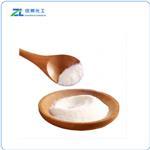Colorless needle or yellow to reddish-purple or brown crystals, flakes. Has an animal type odor.Soluble in ethanol and ether, insoluble in water.
2-Methylindole is an intermediate in the synthesis of indole derivative with potential antifungal activities. It can be used as a raw material for the preparation of deacetylase (HDAC) inhibitor panobinostat.
2-Methylindole is used as a reactant for regioselective synthesis of oxopyrrolidine analogs via iodine-catalyzed Markovnikov addition reaction, Friedel-Crafts alkylation reactions, preparation of tryptophan dioxygenase inhibitors pyridyl-ethenyl-indoles as potential anticancer immunomodulators, Michael addition reactions and in synthesis of cyclooxygenase-1 (COX-1)/cyclooxygenase-2 (COX-2) inhibitors.
ChEBI: 2-Methylindole is a methylindole that is 1H-indole substituted by a methyl group at position 2. It derives from a hydride of a 1H-indole.
2-Methylindole is used as a reactant Reactant for:
Regioselective synthesis of oxopyrrolidine analogs via iodine-catalyzed Markovnikov addition reaction
Friedel-Crafts alkylation reactions
Preparation of tryptophan dioxygenase inhibitors pyridyl-ethenyl-indoles as potential anticancer immunomodulators
Preparation of plant-growth inhibitors
Michael addition reactions
Synthesis of cyclooxygenase-1 (COX-1)/cyclooxygenase-2 (COX-2) inhibitors
2-Methylindole was synthesized from 2-Acetamidotoluene by the following procedure. 2-Acetamidotoluene was added to the mixture of anhydrous ether and sodium amide, heated to 240-260°C under the protection of nitrogen flow, kept for 10min, a large amount of gas was generated in the reaction, and the reaction ended when the gas stopped escaping, and cooled. Ethanol and warm water were added and heated to decompose the sodium derivative of 2-Methylindole and excess sodium amide. After cooling, it was extracted with ether. The extract was concentrated and then distilled, and the fractions at 119-126°C (0.4-0.53kPa) were collected to obtain 2-Methylindole with a yield of 80%-83%. The product can be purified by methanol recrystallization.
Journal of the American Chemical Society, 98, p. 2674, 1976
DOI: 10.1021/ja00425a051Organic Syntheses, Coll. Vol. 3, p. 597, 1955
Tetrahedron Letters, 9, p. 3499, 1968
Crystallise it from *benzene. It has also been purified by zone melting. The picrate has m 139o (from Et2O or Et2O/MeOH). [Cohen et al. J Am Chem Soc 82 2184 1960, Beilstein 20 III/IV 3202, 20/7 V 59.]



